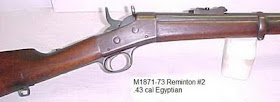What did he have to say? He had been looking on-line and thought that the screws (?) didn't look right for it to be a #4. Before I talked to him again I wanted to do some more research so that I could either convince him that it was a #4 or give him a correct identification. Then I thought that I'd just record my notes here...
The Remington system began with the Geiger split breech rifle about 1865. Too, late for the American Civil War the gun was further developed with an eye to overseas sales, mainly Europe and South America with additional civilian/sporting sales.
One thing that one discovers right from the get go is that there are within the broader categorizations even to models as sold by contract to various military organizations is that there are numerous variations (not different models) as Remington used up parts from other contracts or redirected other contracts which hadn't been paid for to newer clients/contracts. Remington did what other companies did at the time and that is they used intensive management oversight to maximize profits by way of minimizing waste. The used and reused parts as much as possible. Again, variations within variations within models within contracts...
So what actions were there? Well, it seems that somebody has assigned numbers to the rolling block actions, 1, 2, 4, 5, and 6 (actually a falling block).
 |
Remington #1 Rolling Block .43 Carbine, centerfire |
The #2 Remington rolling block is a smaller scale civilian model sporting rifle using a receiver patterned after the 1871 Army pistol. A number of the parts are interchangeable with the 1871, 1891 and 1902 pistols as well as the #7 target rifle. This rifle was produced in a wide variety of rim fire and center fire cartridges. The rim fire models with bar extractors are the most numerous. 1.125" wide it was used for smaller and less "powerful" cartridges than the #1 action. It can be identified by the curved counter at the rear where it joins the stock.
The #3 was actually a falling block action, the Remington-Hepburn.
 |
| No. 4 rifle, for .22S, .22L, .22LR, .25 Stevens ("25-10"), .32S, .32L rimfires |
 |
| Model 1897 7x57mm Mauser Chambering, the #5 |
The #5 Remington rolling block rifles are also known as the smokeless powder cartridge rolling block rifles. Beginning production in 1896 they comprise the 1897, 1902, and 1910 models. While the #5 was produced in several smokeless center fire cartridges the vast majority of them are chambered 7mm Mauser.
 |
| No. 6 Rifle (a falling block), for small caliber rimfires such as the .22 LR |



I recently acquired a #4 rolling block in 25-10 rimfire. The rifle has a octagon to round barrel that is factory engraved on all the flats of the barrel,trigger guard,tang and receiver. Additionally it is beautifully checkered. Sights are Lyman with peep rear. On the butt stock there is a engraved German silver gift etching with the year 1893. I have as of yet been able to find anything out about this gun. Any help?
ReplyDeleteYour best bet would be factory records if there are any. I don't know about that. You could e-mail an inquiry to the Buffalo Bill Historical Center in Cody, WY and ask for their expert advice.
ReplyDelete